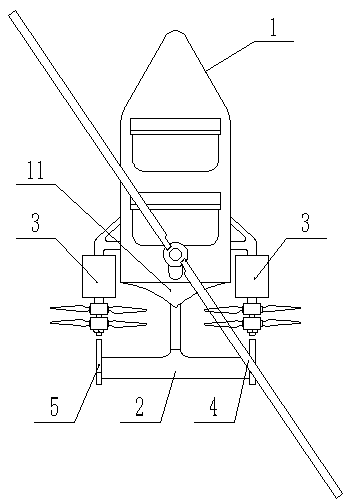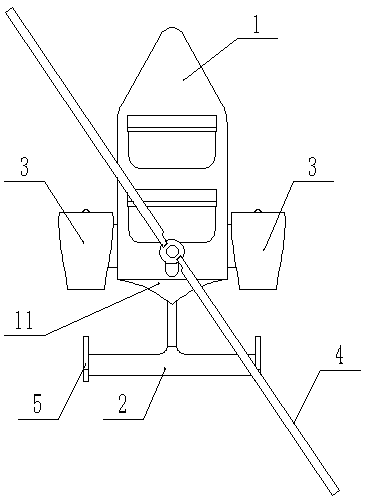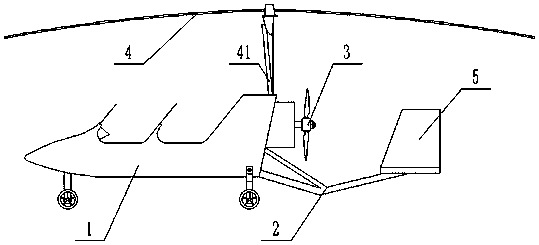Parallel twin-type rotary-rotor aircraft
A rotorcraft and twin-engine technology, applied in the field of aircraft, can solve the problems of reducing engine utilization efficiency and occupant comfort, and the inability of tandem twin-engine autogyro to meet the demand, so as to improve the aircraft's load and flight time, and improve the quality of the aircraft. Effects of safety and simplification of processing methods
- Summary
- Abstract
- Description
- Claims
- Application Information
AI Technical Summary
Problems solved by technology
Method used
Image
Examples
Embodiment 1
[0043] Such as figure 1 , Figure 5 to Figure 9 Shown: Parallel twin-engine autorotor aircraft, comprising: fuselage 1, frame 2, power plant 3, rotor 4 and tail 5; the fuselage 1 is fixed on the front end of the frame 2, and the rear Two power units 3 are symmetrically arranged on both sides, and a rotor 4 is arranged above the rear of the fuselage 1, and the rotor 4 is fixedly connected to the frame 2 through the main column 41, and the rear end of the frame 2 is fixed with the tail 5. The tail 5 is a double vertical tail fin, and the two tail fins of the tail 5 are respectively arranged directly behind the power unit 3 .
[0044] The power unit 3 adopts a rotary engine or a piston engine.
[0045] The power unit 3 is fixed on the frame 2 .
[0046] The power unit 3 adopts coaxial counter-rotating propellers.
[0047] The frame frame 2 below the power unit 3 is provided with a variable supercritical grooved wing 6 .
[0048] A rectifier 11 is fixed at the rear end of th...
Embodiment 2
[0053] Such as figure 2 , Figure 5 , Figure 6 , Figure 8 and Figure 9 Shown: Parallel twin-engine autorotor aircraft, comprising: fuselage 1, frame 2, power plant 3, rotor 4 and tail 5; the fuselage 1 is fixed on the front end of the frame 2, and the rear Two power units 3 are symmetrically arranged on both sides, and a rotor 4 is arranged above the rear of the fuselage 1, and the rotor 4 is fixedly connected to the frame 2 through the main column 41, and the rear end of the frame 2 is fixed with the tail 5. The tail 5 is a double vertical tail fin, and the two tail fins of the tail 5 are respectively arranged directly behind the power unit 3 .
[0054] The power unit 3 adopts a rotary engine or a piston engine.
[0055] The power unit 3 is fixed on the frame 2 .
[0056] The power unit 3 adopts a ducted fan propeller.
[0057] The frame frame 2 below the power unit 3 is provided with a variable supercritical grooved wing 6 .
[0058] A rectifier 11 is fixed at the ...
PUM
 Login to View More
Login to View More Abstract
Description
Claims
Application Information
 Login to View More
Login to View More - R&D
- Intellectual Property
- Life Sciences
- Materials
- Tech Scout
- Unparalleled Data Quality
- Higher Quality Content
- 60% Fewer Hallucinations
Browse by: Latest US Patents, China's latest patents, Technical Efficacy Thesaurus, Application Domain, Technology Topic, Popular Technical Reports.
© 2025 PatSnap. All rights reserved.Legal|Privacy policy|Modern Slavery Act Transparency Statement|Sitemap|About US| Contact US: help@patsnap.com



